Zunoquad 4: Canoeing the Green River, Utah, 2011
September 16
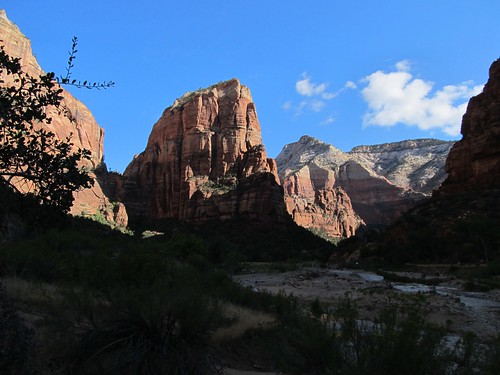
Steve E., Peter U. and I strike camp in Zion National Park after two days of pre-canoe trip hiking and drive Interstates 15 and 70 through beautiful unpopulated country. We stop for breakfast in Richfield, a surprisingly prosperous agricultural town in a long, settled valley, where we joke with the waitress who brings us generous portions of fresh, low-priced food.
A blasting rainstorm in the afternoon causes concern about how we’ll cope with such weather along the river. In the town of Green River, the next settlement located 130 miles down the road, we buy locally grown melons and visit the fair. Pulling into Moab, we’re delayed by a high-school parade that blocks traffic. The three of us spread out in the busy grocery store, and within a few minutes finish last minute grocery shopping for perishables. We meet up John and David, who’ve driven up from Phoenix, eat dinner at a hip Thai restaurant and head to the airport 20 miles north to meet the rest of the crew”five men flying in from Bellingham and Seattle. Sharing a bed in the Red Stone Motel to save money, I find it hard to sleep, from excitement and also anxiety about the two hour rainstorm that pelts the town from 4 to 6 A.M. This is the kind of weather we were prepared for in the Yukon two years ago, but not here.
arrival
to start on a bus
passing thru unknown
is to be alive again
–
continuing in plane
after subway sky train
surviving stopped watch
during last hour
reappearing only at check in line up–
end by flying back over rockies
in plane smaller than powell river’s
with flight attendant also pilot
landing fifteen miles from town
on only long enuf flat spot
˜tween peaks
met by part of other half
to crash in moab
where it never rainsMurray th K
September 17
We all gather at Tag Along, the outfitters, at 8:00 A.M.”any delays, we’d been told would be charged to us at $80/hr”but don’t depart until an hour and a half later due to their short staffing. Two of the five canoes left for us are so dinged up we insist they substitute another two they say are reserved for a different party. They agree and epoxy the hole in the keel discovered in one of the better boats. Dave, the crusty old river rat who drives the van and trailer that takes us to the embarkation point at Ruby Ranch, recites paragraphs from Edward Abbey, the literary voice of this part of the world. The morning’s rainclouds give way to sun beating down with an intensity as frightening as the thunderstorms, until I apply sunscreen, even under my t-shirt.
The van leaves us alone and we enjoy lunch under the shade of riverbank cottonwood trees, making quick work of dividing up the large cargo of nine-days provisions into the five boats. Lionel is appointed team leader for the day and I paddle bow in his canoe. Entry into the swiftly flowing current of the muddy river is blissful: ten people sprung free from the connections of daily life and reattached to this old untrammeled association.
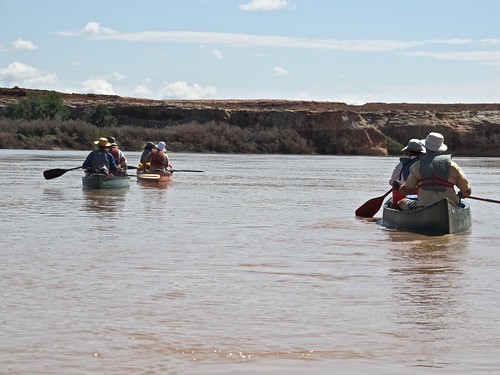
After less than an hour the flat grey desert banks transform into sculpted red sandstone cliffs revealing layers of deposition and erosion produced by the rise and fall of shallow seas over hundreds of millions of years.
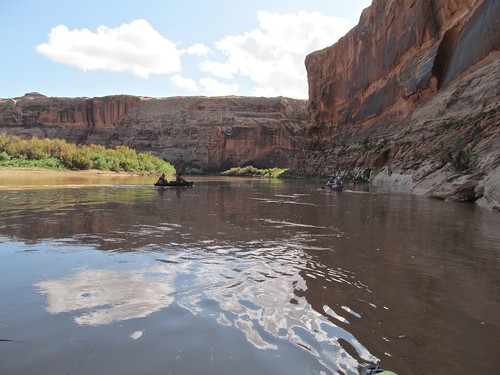
There are no other people on the water or signs of human impact on those banks, except for the relentless thicket of tamarisk clogging the “Bottoms” which line the inside edges of the river’s tight turns. This impenetrable Asian vegetation has driven out most of the native cottonwoods and willows that used to provide open shade and habitat along the shores. It was introduced by government soil conservation officers from the Great Plains to control erosion. They didn’t realize that erosion here was the essence of the riverbank ecology for millions of years.
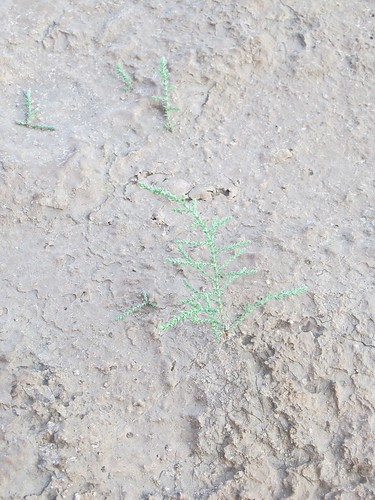
The variety of angle, color, texture, light and shadow overwhelm the senses as the canyon deepens and the scale of its walls reduce the canoes to miniscule toys. But rhythmic repetition soon becomes evident at every level, from the immense meanders of the river’s trajectory to the parallel scratches in the rock polish, suggesting ranks of wing feathers brush-stroked by the wind with an action painter’s abandon.
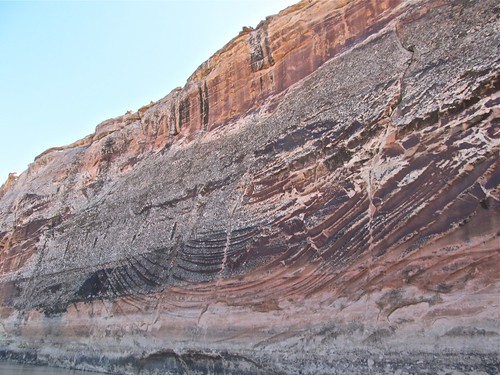
The air is desert-clear, the sky flat opaque blue, the sun hot enough even under hats and sunscreen to make us search out shady patches along the cliffs and revel in their momentary coolness. Occasionally we cross toward the opposite bank in search of a faster flow or to avoid the riffle indicating a submerged sandbar. Passing close to the frescoed walls, we sense the progress of the current bearing snowmelt and silt from a thousand miles upstream down another thousand miles from here to the sea.
At seven miles from the starting point we stop at June’s Bottom, a sandy beach at water level with a thin margin of shade under the tamarisks, where our large 16 by 24 tarp can be rigged by tarpmeister Steve to provide shelter in case of another downpour. We strip naked and jump into the river letting tense muscles be carried by the stream, chilling hot dessicated skin in the thick cool liquid.
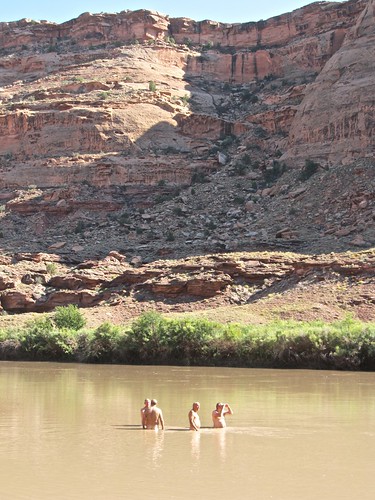
Then ten bodies swarm over the canoes hauling the cumbersome loads ashore. Some gather firewood, some pitch the tarp and their tents, some set up the kitchen, boil potatoes and corn and then barbeque steak, the last fresh meat of the trip. Happy hour is declared and a five-liter box of wine is quickly emptied.
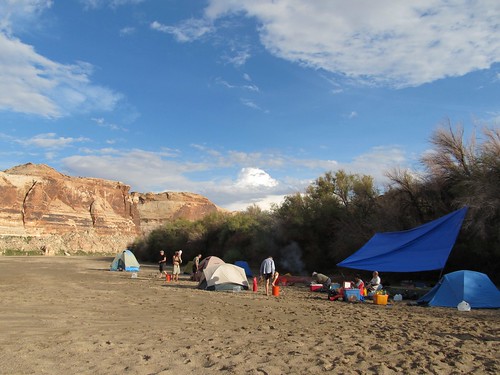
A gray cloud passes overhead and deposits only a few drops of rain. Conversation bubbles and flows: practical coping, group problem-solving, planning the next day’s itinerary and destination, all rendered lyrical by the pure beauty of this place. The average age of the men is determined to be 64”all of us in retirement or at least heading that way, exploring the possibilities of leisure or of new careers.
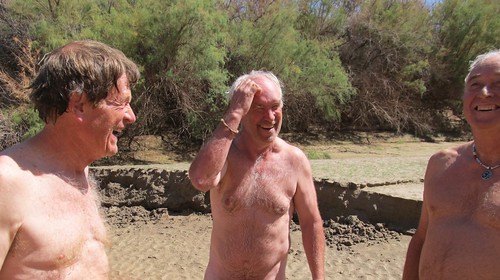
Mosquitos are bothersome for an hour or so around sunset, and then stars cover the black night sky, the spaces between them filling with a misty glow that can be perceived as innumerable points of light.
start
up at five-thirty
to th question of why
do we need four pounds of aluminum sulphate
before three hours
of waiting
canoe loading
and ruby ranch entry history
with mud flats desert moonscape
midst phalfalfa fields
and lunch
before push off
with quick hit of california green for some
and irridescent blue herons
nesting above
three canyon campsite search–
stop at june’s bottom
with enuf time for
dessert first trudy cake
and steak corn potato grilled
before plastic cornhusk refuge burning
over distant political drill debate
and ending before finding mom
by eight thirty or nineMurray th K
September 18
Steven is up before dawn brewing coffee in the comfortable kitchen under the tarp, the stacked totes holding the propane stove fed from a tank. After a breakfast of ham and eggs and oranges, the second day’s commander sets a departure time of 10:30, allowing for more organization of gear and food, for easy access, for striking and packing of camp, for the hallowed ritual of Murray’s reading of his “pomes””brief verse chronicles of the previous day’s events.

Then a surprise addition to the program. Peter U. teaches and leads us in a fifteen minute session of Tai Chi warmup exercises, a circle of graceful movement that mirrors the circle of surrounding cliffs beside the river’s silent flow. This will be repeated every morning of the trip just before departure, providing a brief interlude of group solemnity and meditation.
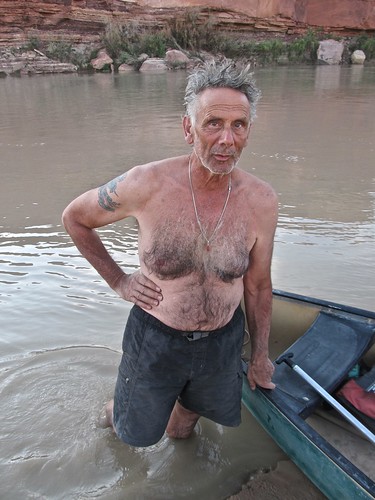
We navigate with the help of Belknap’s River Guide, a well-designed book of maps on waterproof paper that opens to double vertical pages covering sections of the river’s shifting downstream progress in great detail. But, it provides little useful information about campsites, since sandbars and beaches constantly change.
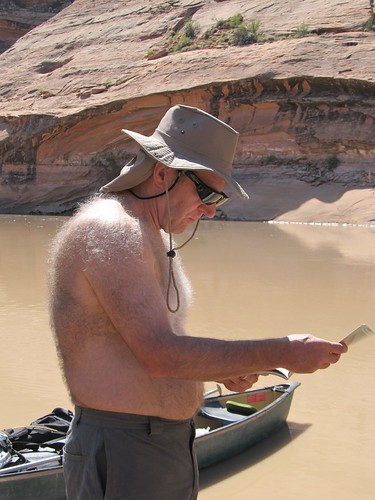
After full-group deliberation the landing location is finally decided by the map holder on short notice since there is no standing still and the canoes need to fight the current, especially on the curves, in order to reach the beach. Places to avoid include those with high banks, excessive mud, claustrophobically close and high walls, and lack of clearance from the bug-infested tamarisk groves. Our route is 97 miles long, roughly 15 per day allowing for one day’s layover.
The winding passage through the canyon seems like a journey through an endless corridor of carved arches, alcoves, columns and bas-reliefs depicting Egyptian gods, Assyrian cherubs and Mayan glyphs, all joined at the top by a continuous cornice.
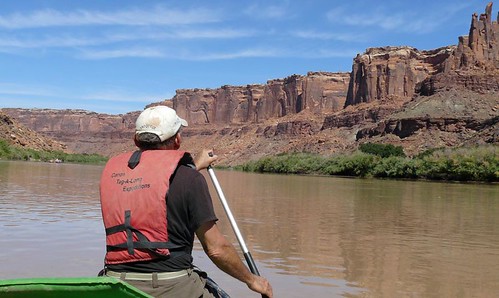
(Peter Behr photo)
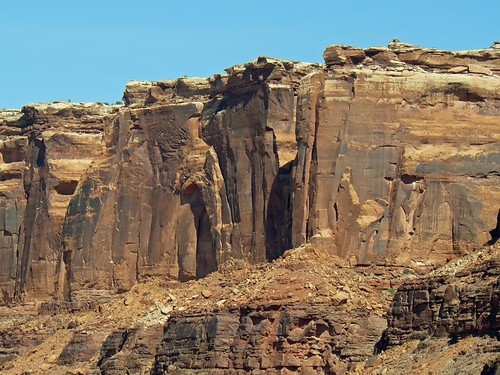
(Peter Behr photo)
Steven and Peter B. are reminded of the reconstructed temples they visited as children in New York’s Metropolitan Museum of Art. All primal visual art, with its symmetry, variation and fantasy seems to have arisen, under appropriate stimulus, from imitation of natural forms like these.
The midday sun requires regular replenishment of sunscreen and frequent swimstops on sandbanks. At 3:00 p.m. we haul out 15 miles from June’s Bottom at Spring Canyon Point, an impossibly tight turn of the river that forms part of the quadruple switchback that John Wesley Powell named “Bowknot Bend.” It’s still hot enough that any bit of shade is treasured. I sit in the doorway of the tent, a location repeatedly mentioned in the Bible, and now I know why. The last of the Green River melon left in the cooler is distributed to laughing swimmers who ride the current and walk back upstream to repeat the fun.
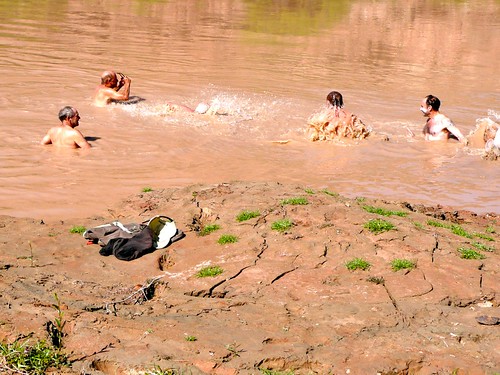
(Allan Best photo)
With the exception of one, the bodies of these men show the effects of wear and gravity. They’ve lost their youthful grace, but in this setting, they shine with confidence.
Downwind and decently far from the kitchen, Peter U. sets up the “Groover,” a heavy steel device that all river runners are required to rent in order to store and pack out their solid human wastes, for both ecological and aesthetic reasons since campsites are small and rare. Topped with a removable toilet seat when set up which is replaced by an odor-proof seal during transport, it’s efficient and agreeable to use.

(Allan Best photo)
Happy hour, oiled by a modest ration of rum, is followed by dinner prepared by Allan our diligent head chef. It includes tacos, refried beans, brown rice, salsa, and fresh guacamole.
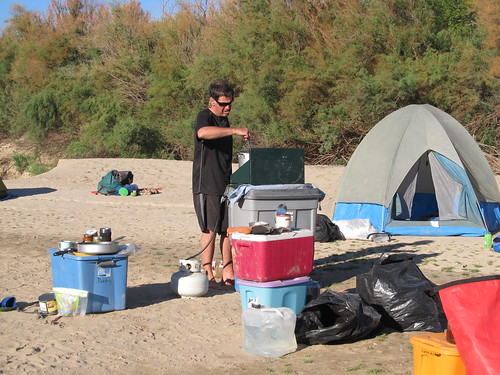
switchback
to be cast off ready
by ten fifteen am
after top grade ham ˜n eggs
with no rickin’ it
is to be able
hopefully
to pass by geology notes
of five miles one way
nine miles another
to end up only
quarter mile from beginning
gives design flaws
and abandoned moments
to end with memories
of taiku for peter–
sixty eight trivia
reveals more canadian american rivalry
than is hidden
by a black box
over lsd memoriestaiku for peter
float beyond tai chi
lotus blossom giving peace
silent hands revealMurray th K.
September 19
An early departure is demanded by today’s leader, after breakfast of coffee, cold cereal and stewed dried fruit, our pome reading, and a session of Tai Chi warmups that seems to do more for arthritis than my usual morning hot bath and dose of Ibuprofen. (Later I wonder whether this relief was actually due to the desert climate.)
One might expect to encounter a rich and diverse array of wildlife along this sole steady source of water in the midst of the high desert, but sightings are rare: small lizards and toads, a kingfisher, a couple of ducks, the occasional crow, and a few jumping fish. Is this absence due to the animals’ natural caution, their nocturnal habits, or some more sinister cause, such as the human impact on native vegetation created by the introduction of tamarisk? One exception is herons, which entertain us daily with their elegant take-offs and landings and with the iridiscent glisten of their feathers in the midday sun.
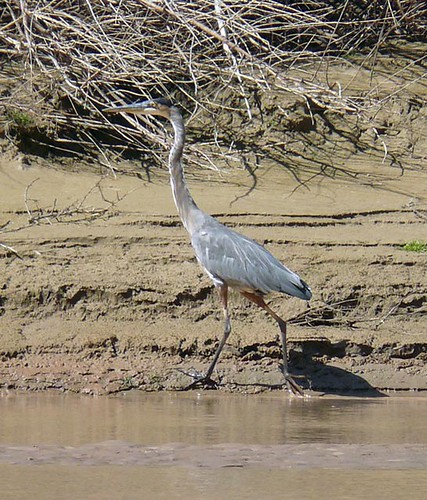
(Peter Behr photo)
A 20-mile paddle along a stretch with few places to overnight brings us to Mineral Bottom, a campsite close to the border of Canyonlands National Park that includes an outhouse, some shady old cottonwood trees and the end of a road that heads back to Moab used by people to access the river for a shorter trip than ours.
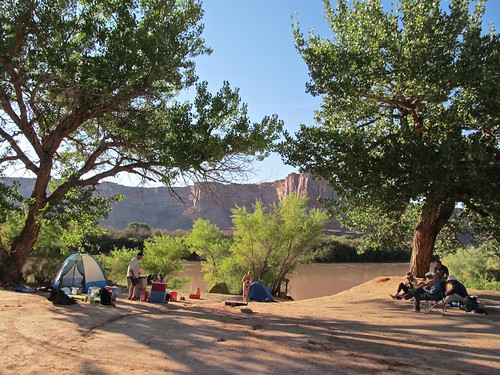
The canyon walls here recede on both sides of the river allowing for an evening hike up broad Mineral Canyon, where many unsuccessful efforts were made to mine for gold, copper and uranium. We enjoy stretching legs and discovering behind the ever-present barrier of tamarisks, widely spaced desert plants and, in the washed out roads and newly carved arroyo, evidence of recent flash floods produced by the rainstorms we witnessed on the way here.
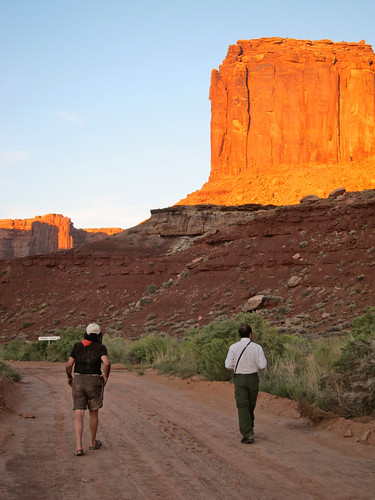
(Lionel Webb photo)
Following the suggestion of the outfitter, we each brought along five gallons of drinking water in plastic containers, but this supply is already running low, so David and Lionel start refilling the containers with water purified by the Katadyn hanging water filter. But first the silt in the river water needs to be settled by sitting overnight overnight in five gallon buckets to which has been added two teaspoons of Aluminum Sulfate, a chemical normally used to make Hydrangeas look more blue.

Happy hour depletes our second and last box of wine. After dinner of fried rice, fresh cole slaw and canned salmon, John reads aloud chapters from John Wesley Powell’s account of his 1869 expedition down this river on his way to the Grand Canyon.
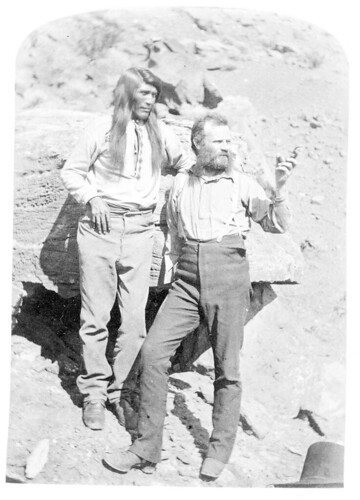
He described this section of a trip that later turned terrifying and brutal as a peaceful idyll. Above the campsite a grand butte glows in the setting sun.
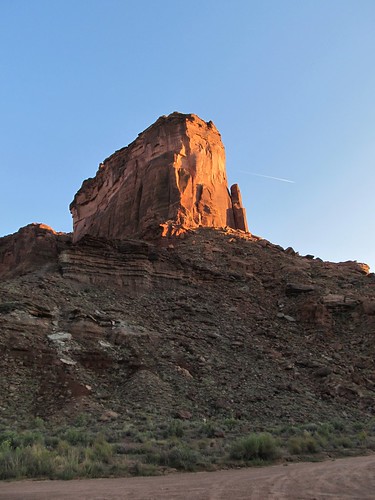
mineral bottom
tai chi exercise start
before quick swim bow tie beyond
gives filling between
next to nothing instructions
at mineral canyon bottom
while analysis
of state of th union
dinner prep offers
questions about
enlightenment being possible
dependent upon whether or not
outhouse graffiti is profound–
sunset hike into hills above
offers supposed mosquito refuge
for those who go
and inner silence for left behind
at orange sunset solitude
with historical perspective
to reveal
and distant hopes
to remainMurray th K.
September 20
Unloading and loading the canoes at the steep embankment that affords great views of the river at Mineral Bottom is awkward. There’s general agreement to stop next at a place that looks as if it affords even more shore attractions and doesn’t require a long day’s paddle, Fort Bottom. Ahead of us during most of the 11 mile paddle looms a great gateway formed by two high escarpments with pillars at each side flanking a low platform through which distant formations can be seen, both upstream and downstream as we approach, circling clockwise and then counterclockwise following the river’s path. “Big Horn” Mesa is the name stated on the map, but from the water the formation looks like something other than a horn.
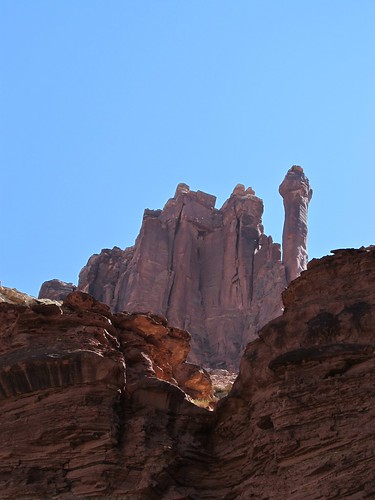
The sandbar at Fort Bottom is long and wide, its lower end bordered by a little inlet and a low bank mounted by a trail. There’s an overhang topped by willows rather than the hostile tamarisk, providing shade for a siesta after lunch and a swim. I weave a garland of twigs to substitute for the adequate hat I neglected to pack.
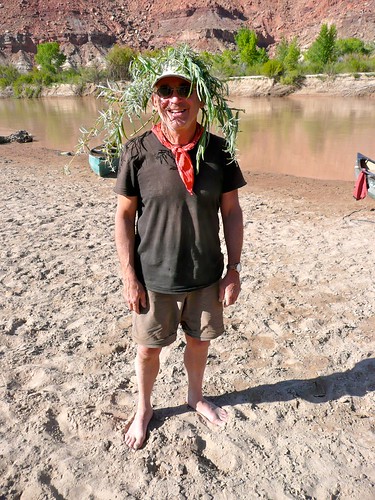
(Allan Best photo)
A short hike late in the day leads to “Outlaw Cabin,” located in the middle of a plateau 200 feet or so above the river which curves behind it.
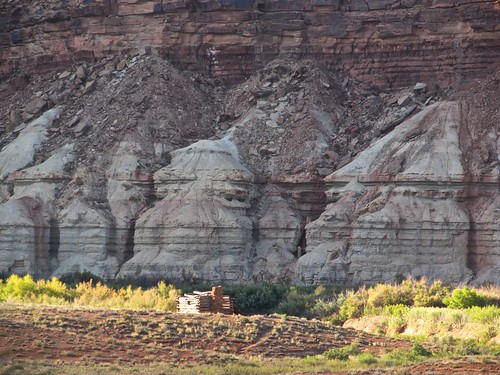
Built in the early 1900’s with a hand axe out of cottonwood logs, and graced with a fireplace chimney of sandstone slabs, it’s the only human habitation we’ve seen in four days. In addition to its ability to survive here unprotected and uninhabited for more than 100 years, one is struck by the crude beauty of its proportions, materials and setting.
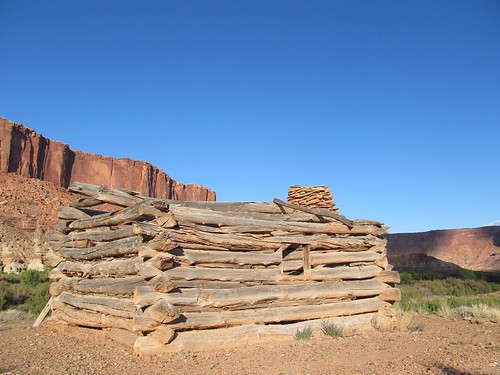
It’s reminiscent of the old prospector’s cabins we found in the woods along the Teslin river in the Yukon and dates from the same period. The guidebook reports that some inhabitants of this area left for the Klondike to continue their search for gold.
Dinner tonight is pasta”glutenous and gluten-free”marinara sauce, and cheese. At the campfire, Steven reads from Edward Abbey’s book, Down the River, his 1980 account of a trip on the Green River from Mineral Bottom through Cataract Canyon on the Colorado.
We glide down the golden waters of Labyrinth Canyon. The water here is smooth as oil, the current slow. The sandstone walls rise fifteen hundred feet above us, radiant with sunlight manganese and iron oxides, stained with old tapestries of organic residues left on the rock faces by occasional waterfalls¦I get up before daybreak¦kindle the fire and build the morning’s first pot of black, rich cowboy coffee¦the first cupful, warming my hands around the hot cup. The last stars fade, the sky becomes brighter, passing through the green glow of dawn into the fiery splendor of sunrise¦the others straggle up, one by one, and join me around the fire. We stare at the shining sky, the shining river, the high canyon walls, mostly in silence, until one among us volunteers to begin breakfast. Yes, indeed, we are a lucky little group. Privileged, no doubt. At ease out here on the edge of nowhere, loafing into the day, enjoying the best of the luckiest of nations, while around the world billions of other humans are sweating, fighting striving, procreating, starving. As always I try hard to feel guilty. Once again I fail.
It includes a description of this very spot: “We make lunch on crackers, canned tuna, and chopped black olives in the shade of a cottonwood by the side of a long-abandoned log cabin. A trapper, prospector, or cow thief might have lived here”or all three of them”a century ago¦The roof is open to the sky.”
We agree to lay over at this campsite another night and next day hike up to the Anasazi ruin on top of a low butte, the last remnant of the canyon wall that used to define the tight curve of the river.
Upstream sunset–full size panorama (Lionel Webb photo)
taiku
escaped wine test to
hard scrabble bottom gets you
fantastic rescueMurray th K.
September 21
The dawn breaks as caught by Abbey’s prose and the camera”directly in the East, since this is the holy day of Autumnal Equinox.
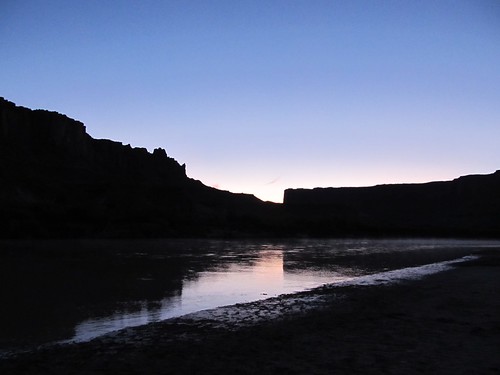
We have a brief breakfast of coffee and granola in order to hike before the heat of the day makes it prohibitive to be far from shade and water. Murray is encouraged not to take on the steep climb, but follows his own lights and eventually makes it to the top with a little help from friends, which includes the loan of Ian’s trekking pole to supplement his cane. He discovers that the use of two poles is just what’s needed to facilitate the alteration of gait suggested by his Alexander technique physical therapist.
We arrive on the surface of the little butte just as the sun clears the distant edge of the canyon.
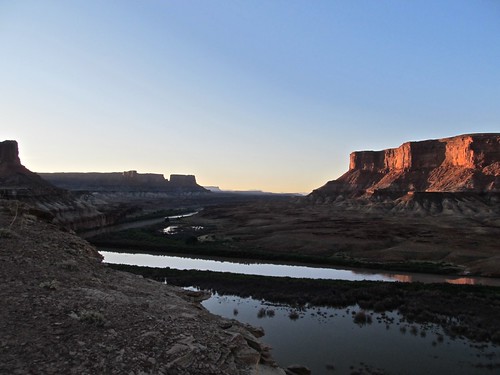

Downstream sunrise–full size panorama (Lionel Webb photo)
For the first time in days our viewpoint changes from bottom up to top down. We see the river making an almost complete circle around us and extending for many miles upstream and down.
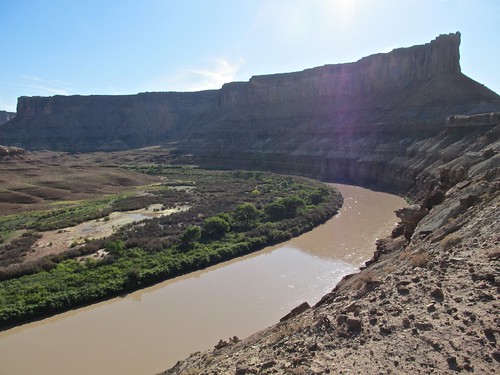
In the growing light we see a vast array of buttes, and mesas and columns reaching to the horizon in all directions, with no sign of human habitation.
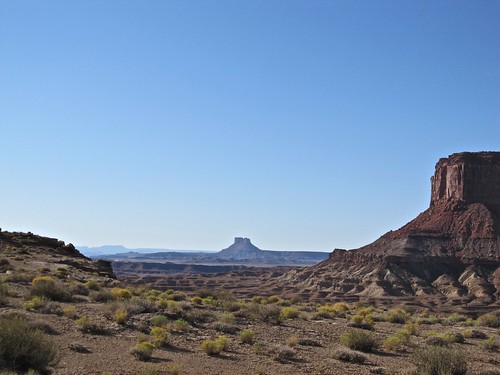
Just at the center of the elevated platform stands a twelve foot tall cylindrical tower built of crudely piled brown sandstone tiles, accessible through a lower attached vestibule.
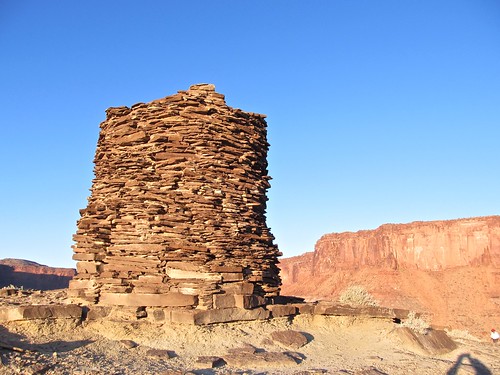
I lie down inside and look up at the irregular oval of the sky and at points of light shining through gaps in the tiles.
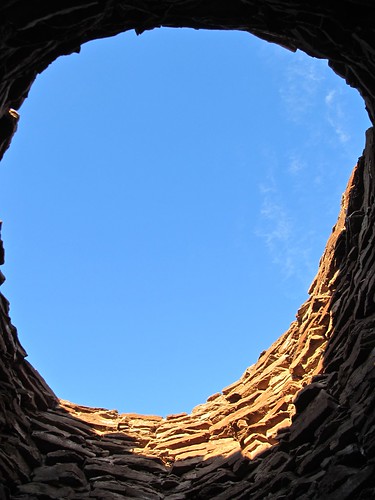
What was this thousand year old structure? A fort seems unlikely. Enemies who reached the top of the butte could surely take this small flimsy structure apart. A granary? But the other granaries tucked into cliffs along the way were clearly made to be hidden, not like this one to stand out. Perhaps some kind of observatory of the heavenly bodies passing across that oval frame, some site of worship.
Once curiousity about the tower is satisfied, Peter U., who by now has become group shaman, leads us again in Tai Chi meditation.
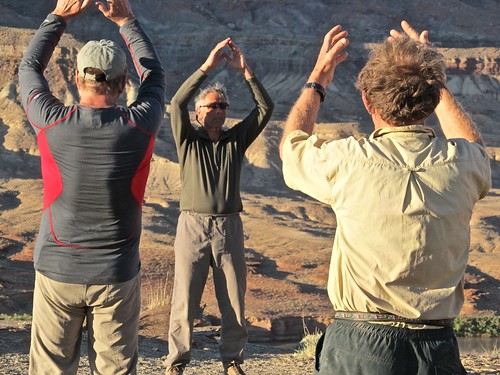
He encourages us to feel the energies of heaven flowing through our moving bodies to earth and the energies of earth rising through them toward the heavens, to experience our being at the center.*
I forgo taking part in order to shoot a short video.
Murray reads his poem-chronicle of yesterday’s events. Then we split into groups heading different ways. John and I follow a trail that goes from the butte up toward Big Horn across the decayed ridge that used to be canyon wall.
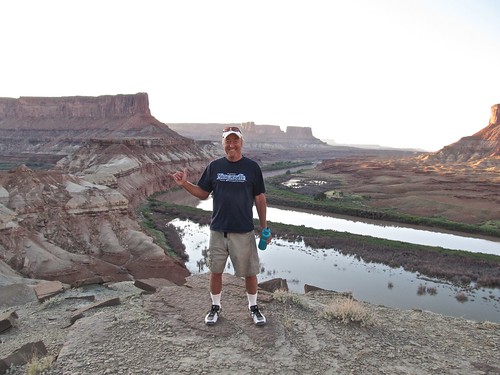
We sense the minute-by-minute changes in the sun’s position altering the light as well as the changes in geological time by which wind and water have altered the terrain, wearing away vast volumes of the absent rock.
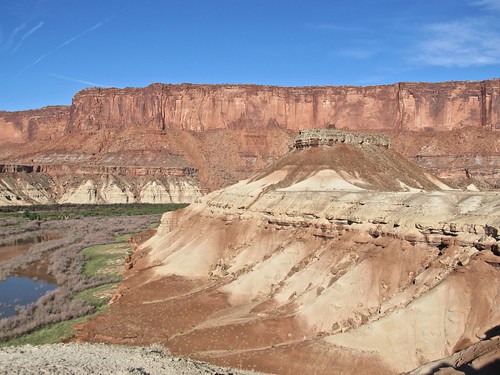
Assembling back at camp in time for lunch, we spend the afternoon swimming, chatting, reading, writing, and basking in the living presence of river, earth and sun. Cigars are enjoyed by some, along with the last ration of rum enjoyed by all during Happy Hour.
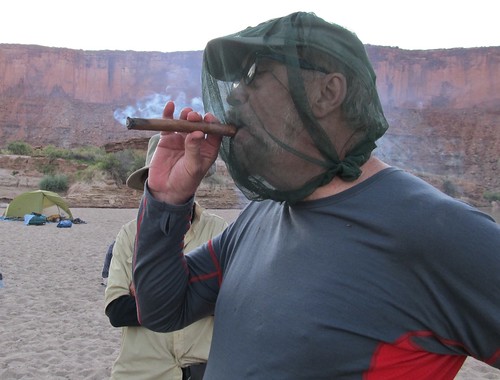
Dinner consists of yams, cabbage, stewed dried apples and quinoa, cocoa and marshmallows for dessert.
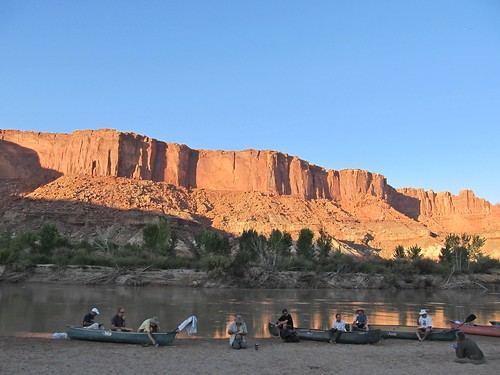
Someone proposes that we have a discussion of “Sex after Sixty” at the campfire, but after John’s recitation of Powell’s harrowing account of rapids on the Colorado, the plan is forgotten in favor of sleep.
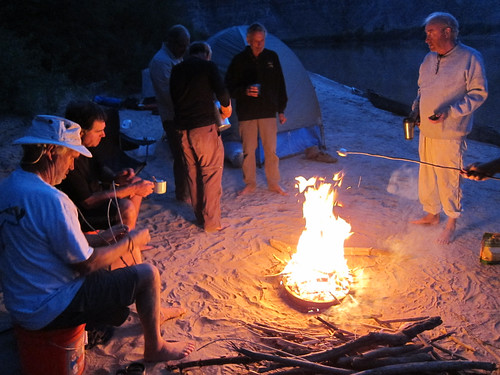
(Lionel Webb photo)
360 degrees
tai chi peak sunrise
stone cabin wind blow
three sixty degree red cliffs
above crumbling log cabin
cactus sagebrush anthills
gives rest day distance
from heat of mid day travel
evening concert
at quinoa bottom
with hot chocolate marshmallows
and history tales
where walls rise without
serious probabilities
of escaping rising rivers
and desperate extremes
of pirates drunken sailors
and saturn blend together
with personal histories
properlyMurray th K.
A poem by Allan written in 1992
INSIDE OUT
Like an eagle, he stood on the canyon rim
Eyes to the cresting sun
Planting his heels to the centre of the earth
Stretching his soul from his soles to the sky.He’d been here before
Feeling the swift soar of flight
Diving and swooping the deadly dance of manhood
Then rifling down to seize the prey.Then he’d drawn his energy from the world around
The wind, the sky, and the sun.
The power was the victory
The sweetness of conquest.And here he was again, older, quieter
Back to the canyon, back to the rim
Drawn by a vision, a song from the past
Focused on the moment, waiting for the moment.Now the canyon light is softer
A warmth grows from the inside out
Etching deep beauty on his heart
Searching for a new and gentler way.How can this be, the hunter silenced
By a hungry splendour mushrooming within
What is this power, this deeper vision
How does the hunter make friends with the wise man?Still like an eagle, still ready to soar
Feeling the power, straining to go
But grounded and growing
From the inside out.
September 22
Next morning finds us eager to move down the river again after Tai Chi and poetry to discover what lies around the bends. A long straight stretch is dominated by the steadily enlarging prospect of two towers that Powell’s men named “Butte of the Cross.”
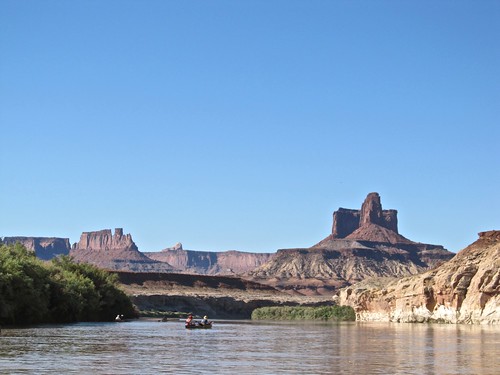
We hope to be able to camp adjacent to a formation dubbed “Turk’s Head,” in order to explore more ruins located around it, but the closest sandbar is smaller than the one shown on the map, so we continue around the corner to a beach across the river from Turk’s Head that allows no land exploration.*
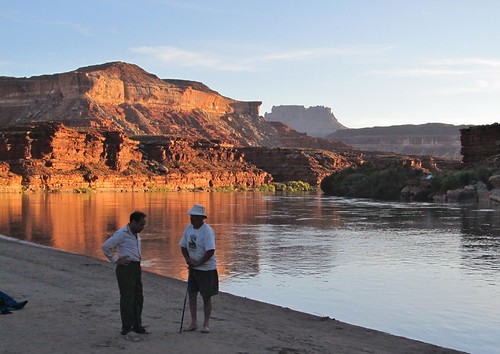
But it does provide a comfortable setting for our dinner of Thai curry and rice.
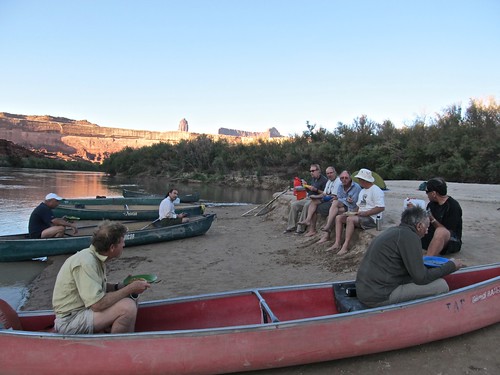
The Convergence with the Colorado and the end of the voyage is approaching, and every bit of the by-now familiar routine is experienced as precious.
*A picture of Turk’s Head, scanned from the book, Robber’s Roost Outlaws by Tom McCourt, the book for sale at the motel in Moab (from Lionel)
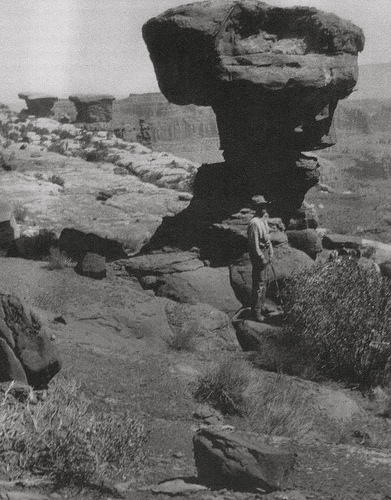
turkish head
willing to push on
past muddy first landing
is sign of flexible ageing
resulting in quality
conclusionsilence of tai chi grace
in time with
wind swept sunset
˜neath turkish head
stark walls
of autumn’s early beginnings
giving needed room
for left bank jasper sharing
and time for early to bed
recoveryMurray th K.
September 23
Peter U., the day’s leader, decides we’ll take a paddling break at Jasper Canyon at mile 10, that is about 85 miles on our way, in order to check out the ruins there and hunt for Jasper. The landing is tricky: one canoe is sent to test it, succeeds in tying up on land and then waits to receive the others and tie them on to the secure canoe. A trail is found, and like all other trails and campsites so far, shows admirably little sign of human disturbance, due either to the conscientiousness of the thousands of campers who have enjoyed the canyon or to the National Park Service’s invisible maintenance activities.
Peter B. climbs up to the cranny that nestles a little mud and sandstone cylindrical structure with a window that is assumed to be an Anasazi grain storage unit. It looks as much like one of the many swallows’ nests in these rocks as a human edifice.
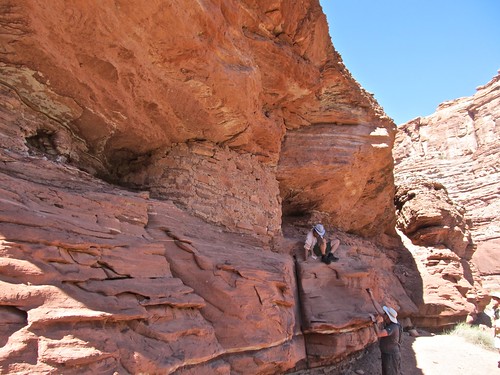
Some people wander to the end of the box canyon finding samples of Jasper, others clamber up the sides for a view of the river but are unable to make it to the top of the cliff.
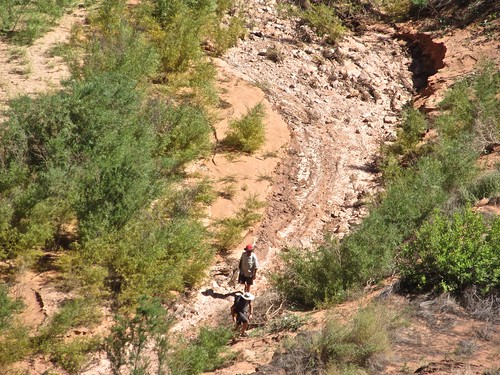
Then it’s back on the river and around one more serpentine to a wide beach under a dramatic rock column.
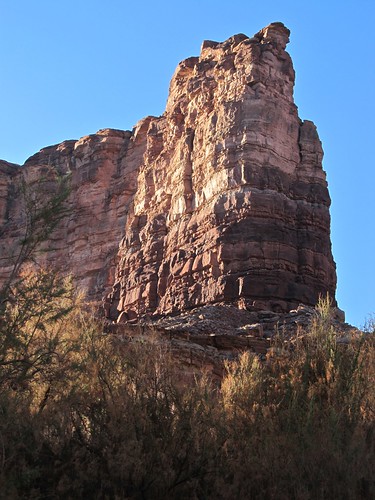
A brief moment of drama unfolds as an unsecured canoe slips off the bank, heads downstream and is rescued in a quick maneuver by Lionel and Dave.
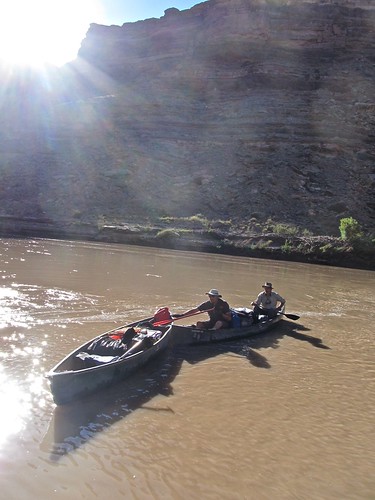
Tarpmeister pitches the kitchen and parlor shelter freestanding with a tripod of driftwood poles.
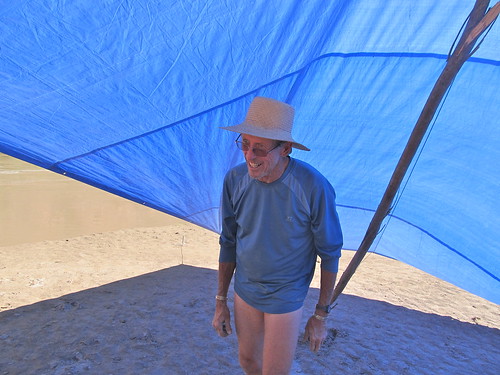
As well as creating necessary shade, it captures wind and light and makes a piece of graceful sculpture that harmonizes with its setting.
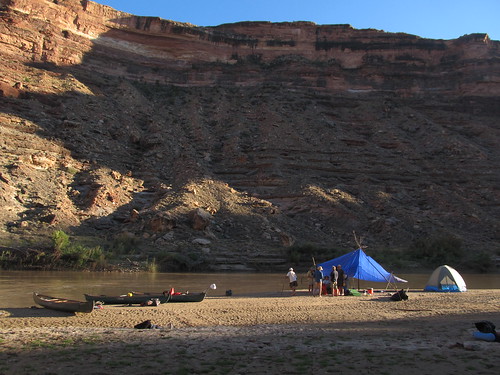
The sand on this bottom is soft, deep and brilliant white, sloping from a seven-foot depth upstream gradually down to meeting the water’s edge. Chunks of the banks regularly give way and slide into the river, creating a white froth that flows into smooth spiraling patterns. Some men accelerate the movement of this natural kinetic sculpture, riding the sandslides into the water and letting themselves be carried by the current to the kitchen on the beach and worrying those whose tents are pitched on the higher ground. Dinner tonight is pasta, pesto, sundried tomatoes and cheese.
jasper
quick time beyond horse canyon
before island lunch
finding mythical jasper
allows back eddy refuge
beside fully engineered
kitchen tent
with gourmet pesto
produced beside tales
of colorado john wesley powell yesteryear
and bug free
tropical evening plans
for trips to comeMurray th K.
September 24
As on all previous days, the pairing in the canoes changes and there’s a scramble to secure the better boats and to avoid the worst one, dubbed “The Dumpster,” which is so misshapen that the steel pipe stabilizing the interior of the keel is twisted four inches off the kevlar surface.
We navigate the last few turns of the Green River before it ends its long course and disappears into the Colorado, staging for a moment a group photo with each man carrying one of the letters, M O V I N G P L A N E T, brought along by Steven to take part in the worldwide demonstrations scheduled for this day by 350.org to urge governments to act to address climate change.

The confluence itself, though a notable geographic phenomenon when viewed from above, is unimpressive on the surface of the river. We pass by two parties of campers waiting for pickup at a sandbar there and then continue down the Colorado to our next day’s rendezvous point known as Spanish Bottom.
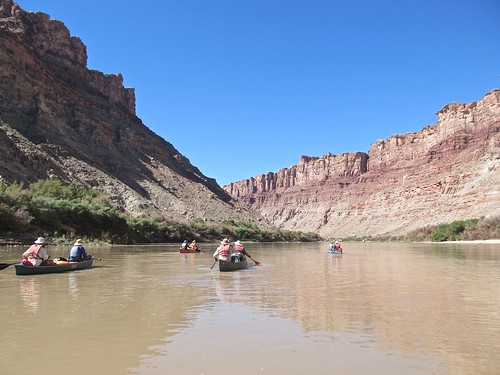
There’s a bit of apprehension, after we pass a warning sign about dangerous rapids ahead and small patch of turbulent water, that we may miss the pullout and be swept into Cataract Canyon, but it’s allayed when we find a long beach for our final destination.
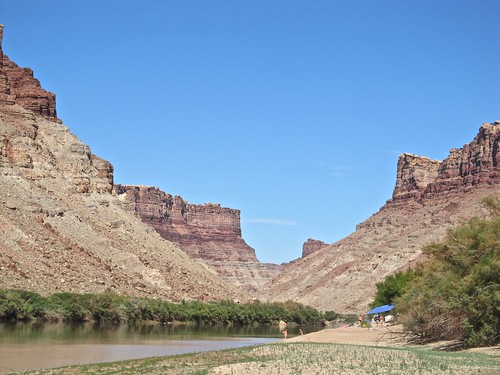
Canoes are pulled ashore and washed. The kitchen is set up for the last time, and several of the group follow a trail through willows and cottonwoods on the broad bench behind the tamaracks that leads around another bend in the river to the top of the Cataract.
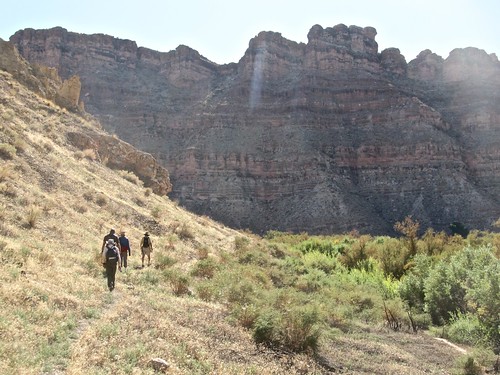
The rapids would be impossible to negotiate with our clumsy canoes, but while we stare a couple of inflatable rafts approach slowly from upstream, packed with gear and steered by what appear to be experienced guides conducting passengers. They bob quickly through the loud cascade and meet up in the quiet water below.
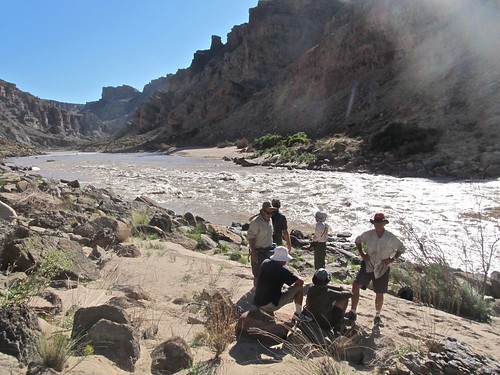
We set up a final group portrait.
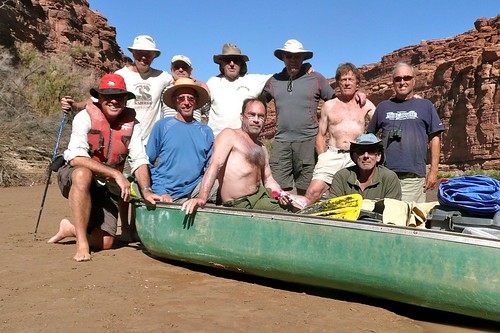
(Allan Best photo)
The last night’s meal is couscous and lentils and nutella, chocolate and other sweets for dessert. Thought and conversation turn to the world beyond the Green River: dividing up the leftover supplies, travel arrangements further afield or back home, and a world-wide range of possibilities for next year’s trip.
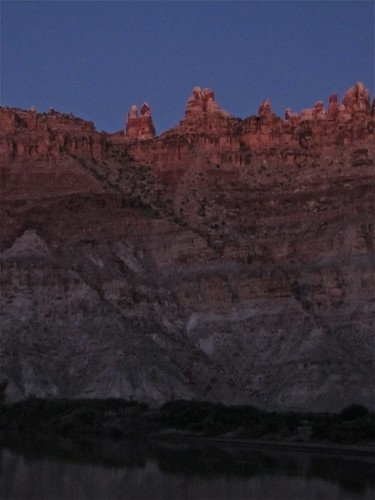
confluence
finished before we started
with mud on th blisters
and mispelt moving planet
before Spanish bottom
hidden hikes
to burn afternoon away
for most
while populated clothed river memories
fills th rest–
eighteen sixty history stories
with next corner unknown
and rapids for real
is so much more
than documented reality
todayMurray th K.
September 25
Peter B. leads an early expedition of hikers up the Lower Red Lake Canyon, on the way discovering wildlife, including deer, lizards, toads and a rattlesnake. Camp is struck after lunch in preparation for the arrival of the Jet Boat at 1:00 p.m. We load it with the canoes and the gear, including the very full Groover. The driver, whose mother and dad are on the boat just for the ride, delivers the case of cold beer which we had arranged for in advance, and we sit like tourists on the three hour ride up the Colorado to Moab, where a bus waits to take us back to town.
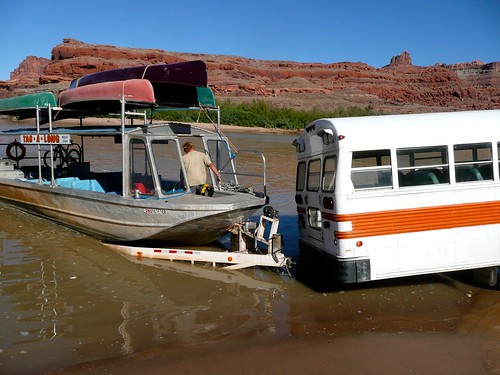
(Allan Best photo)
th grotto
to see morning cataract
with lizard rattlesnake antelope
moumtain top
before on time tag along pickup
and walking stick lesson
in way of colorado start
and two beer three hour up river return
with moving picture
round each corner
as all flashes back
faster than can be remembered
so similar
but different enuf
to stay transfixed–
canoes beyond coal
and passing uranium potash
mixed with full symphony
grand piano concert
boated in to th grotto
for all to hear
at just missed
moab music festivalMurray the K.
return home
main street city market
breakfast lunch grocery souvenir shop
before three hour
air conditioned airport wait
stretches to four hour
apprehension–
taking off at last
gives mountain views beyond
cloud cover interference
bringing forest regeneration
from above bumpy ride
to rocky other side
where chain restaurant airport dinner rescue
gives restful leg room west coast flight
for most
and rapid return
to safety of homeMurray th K.

